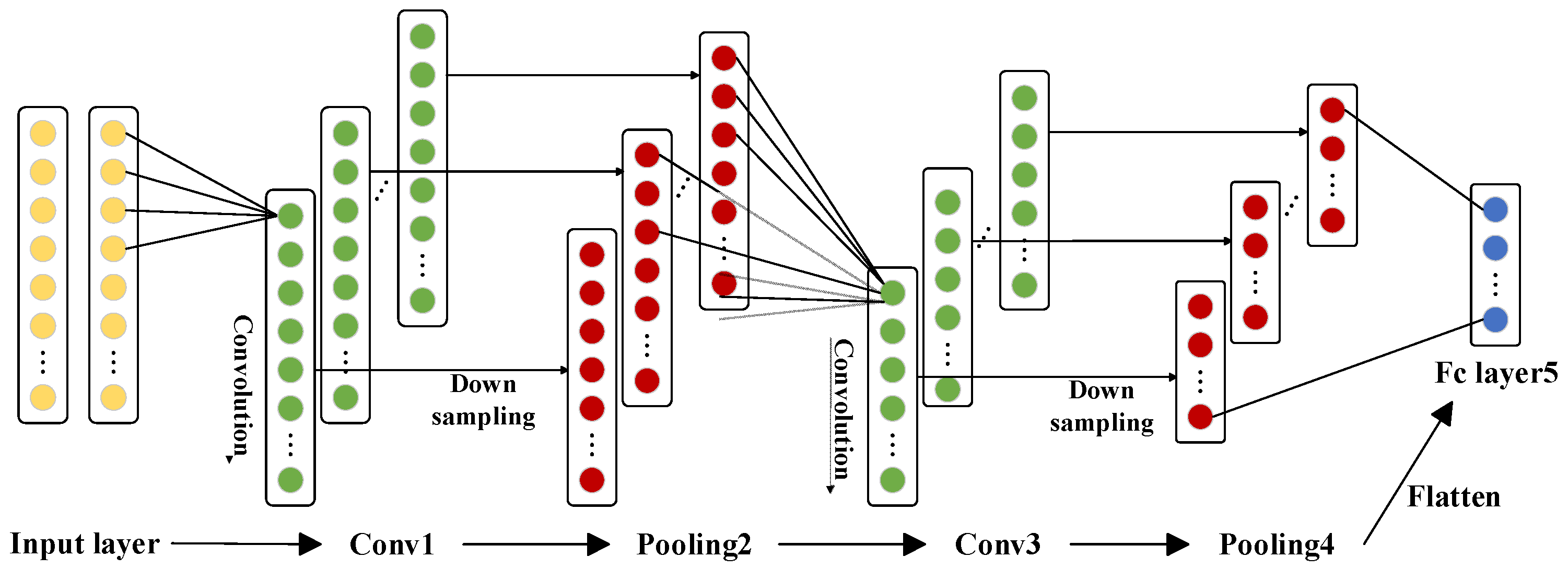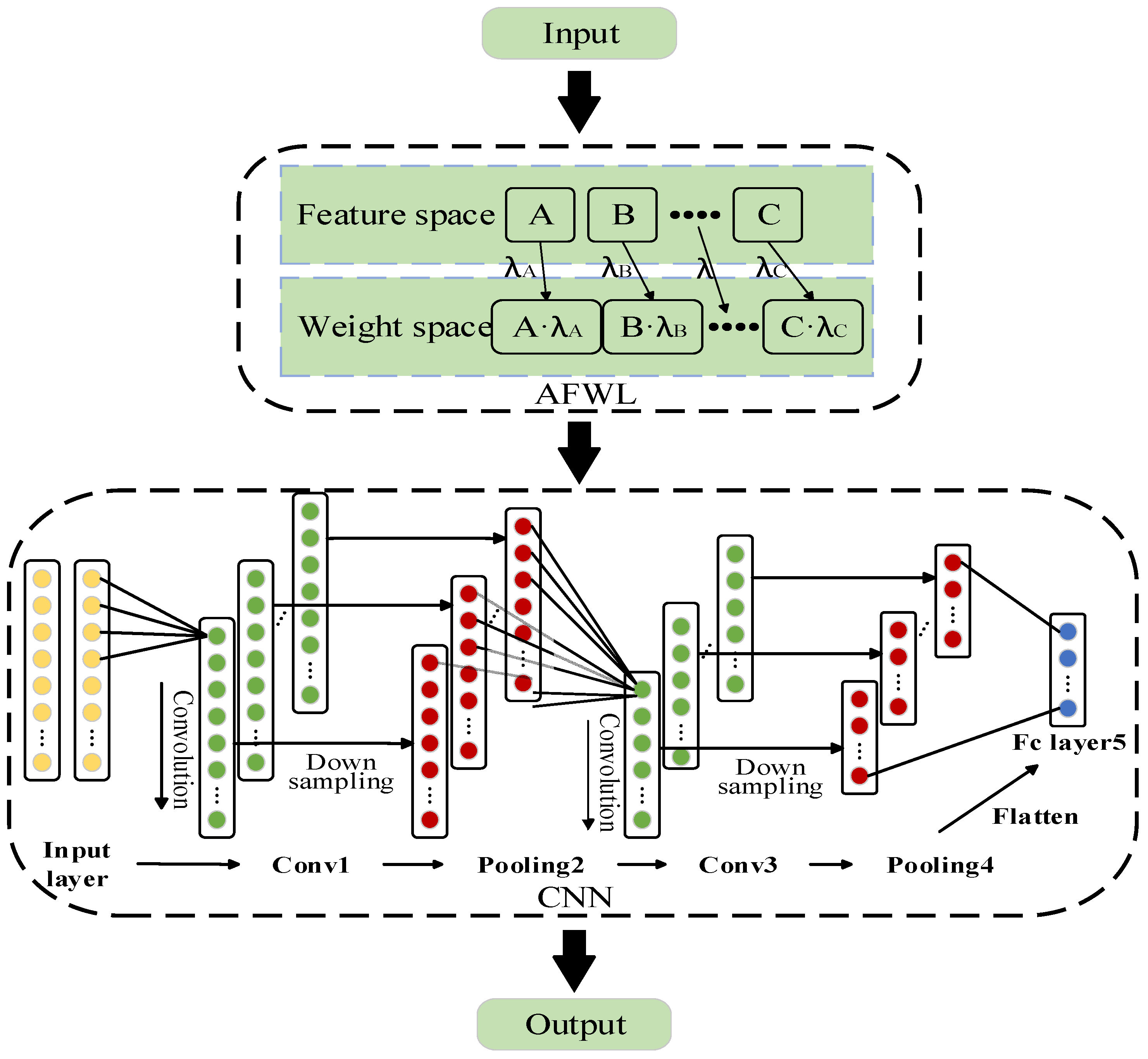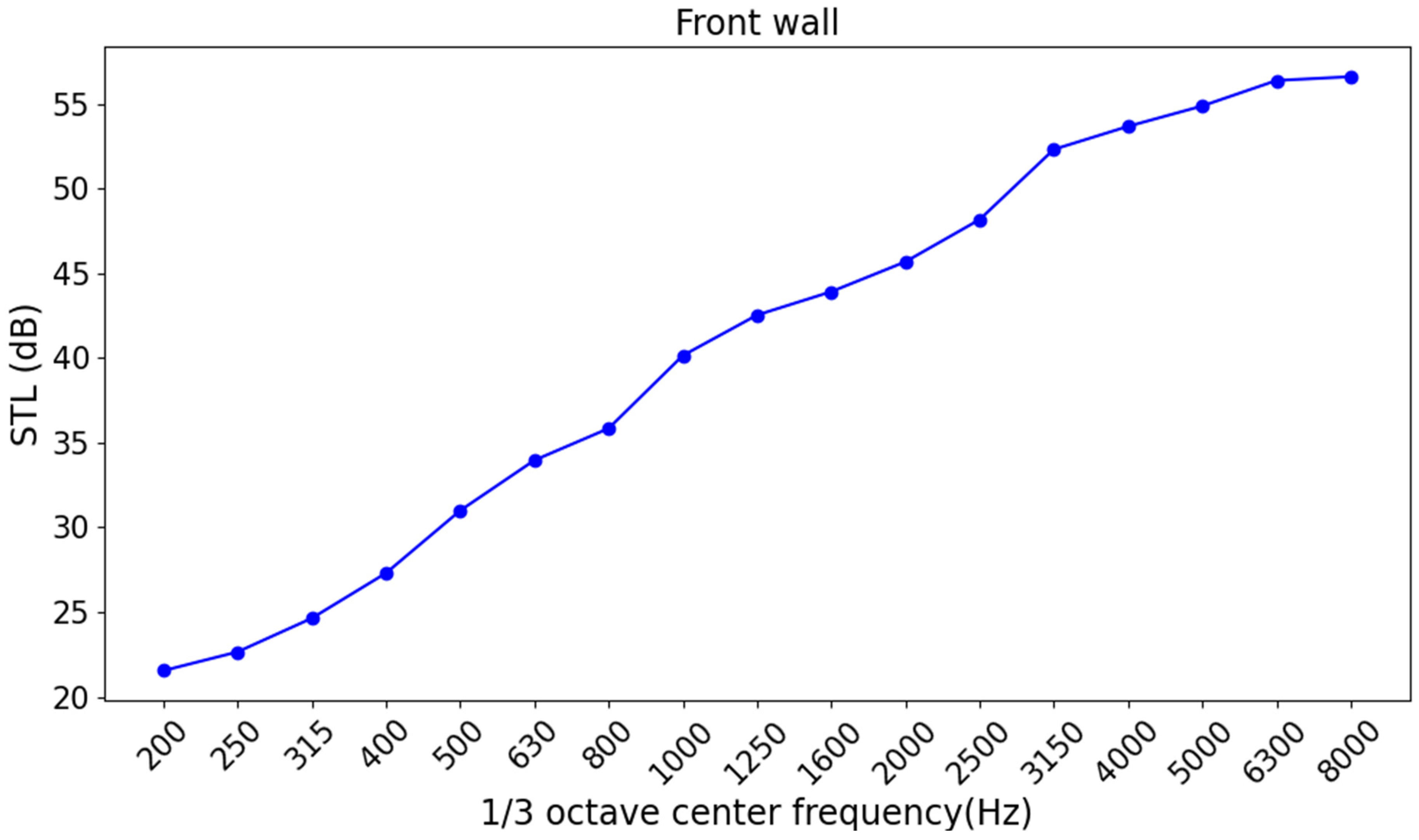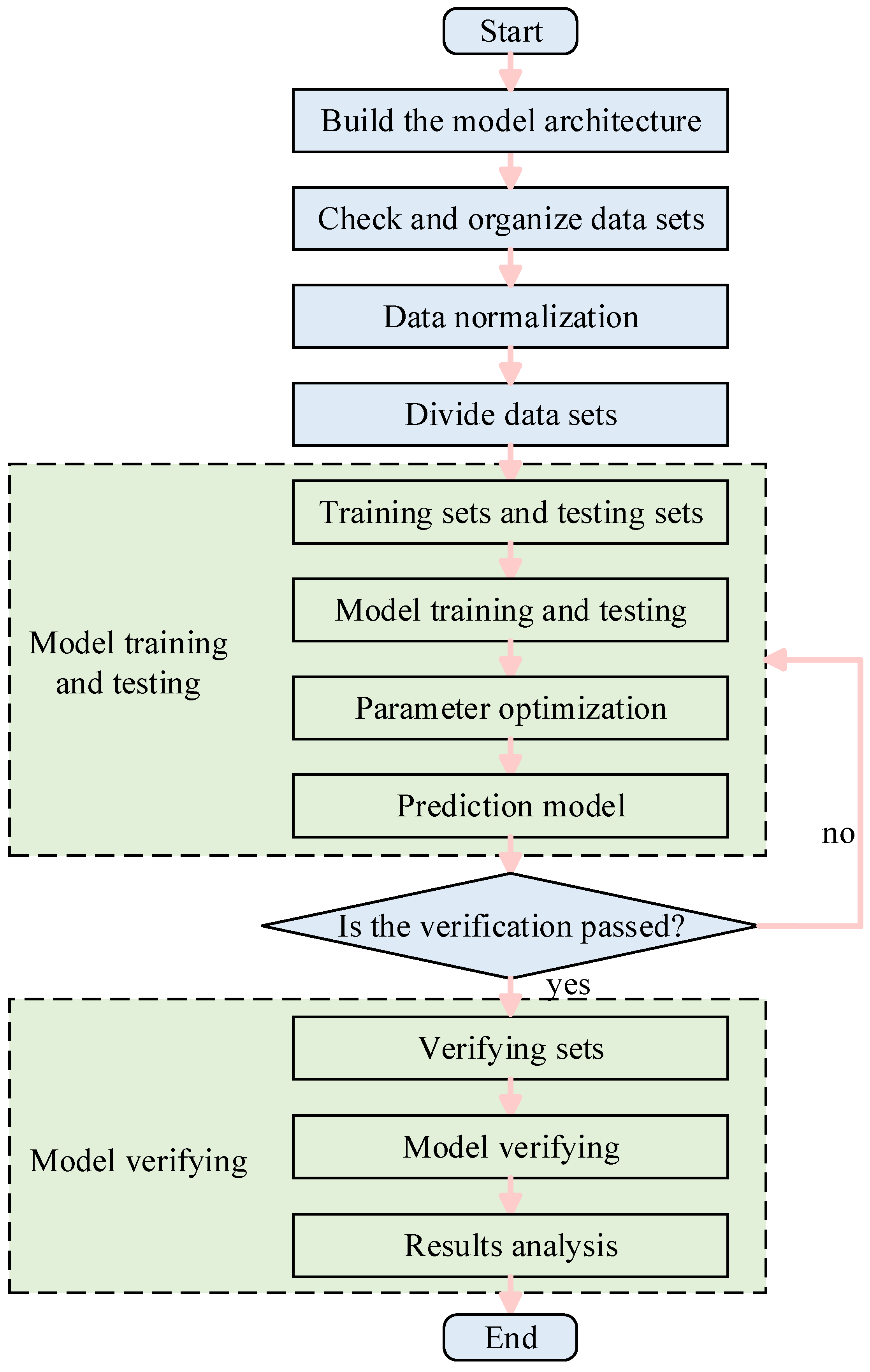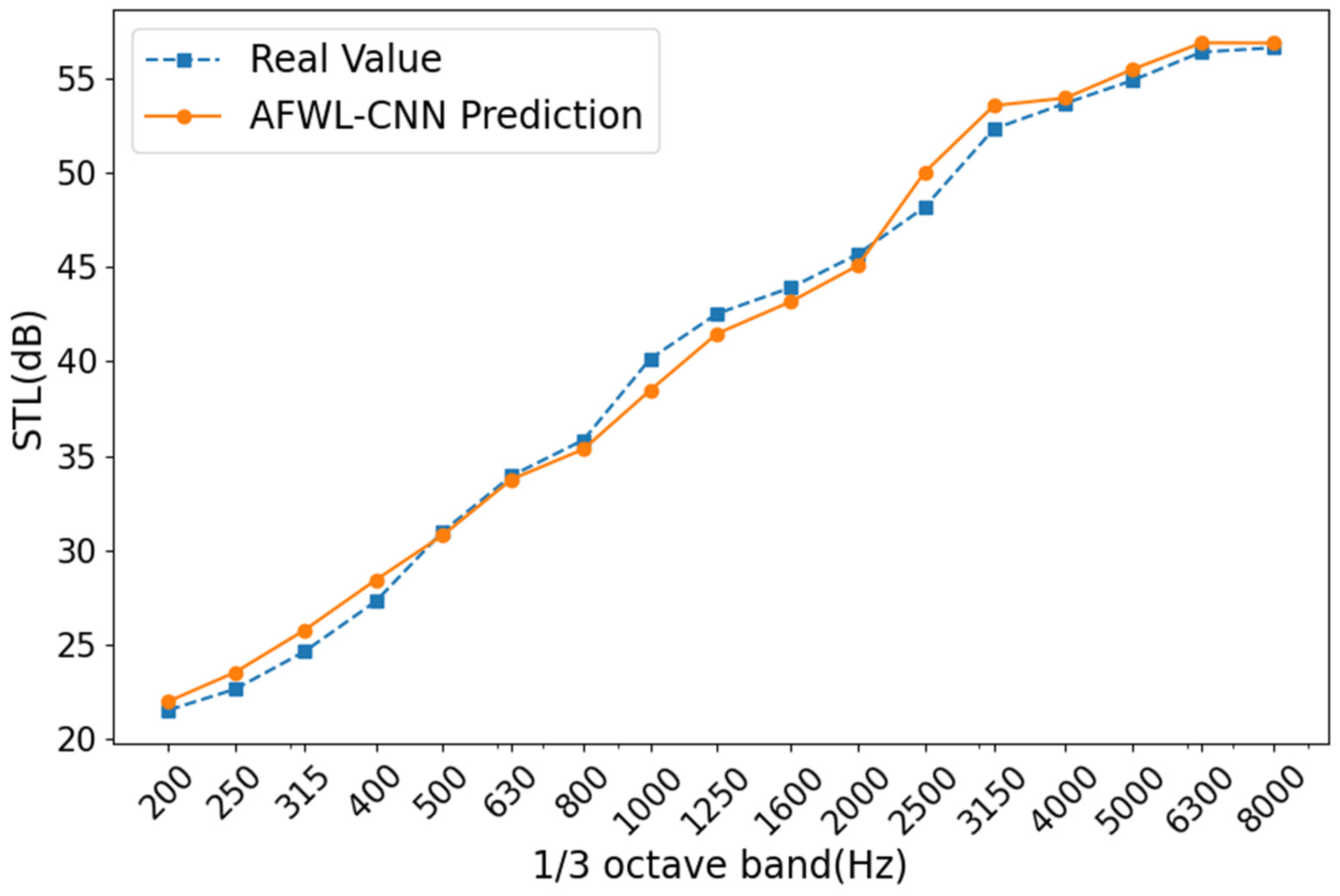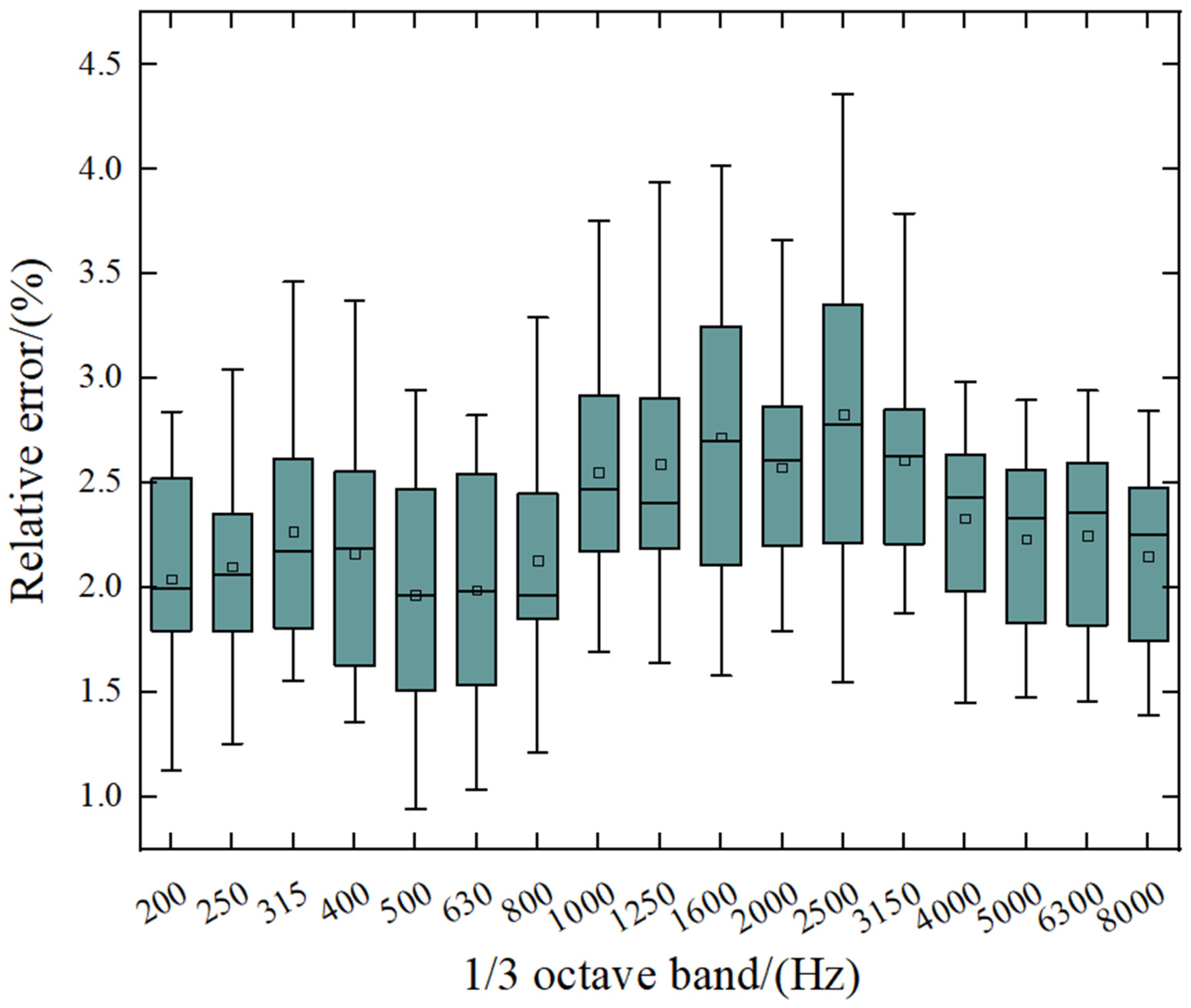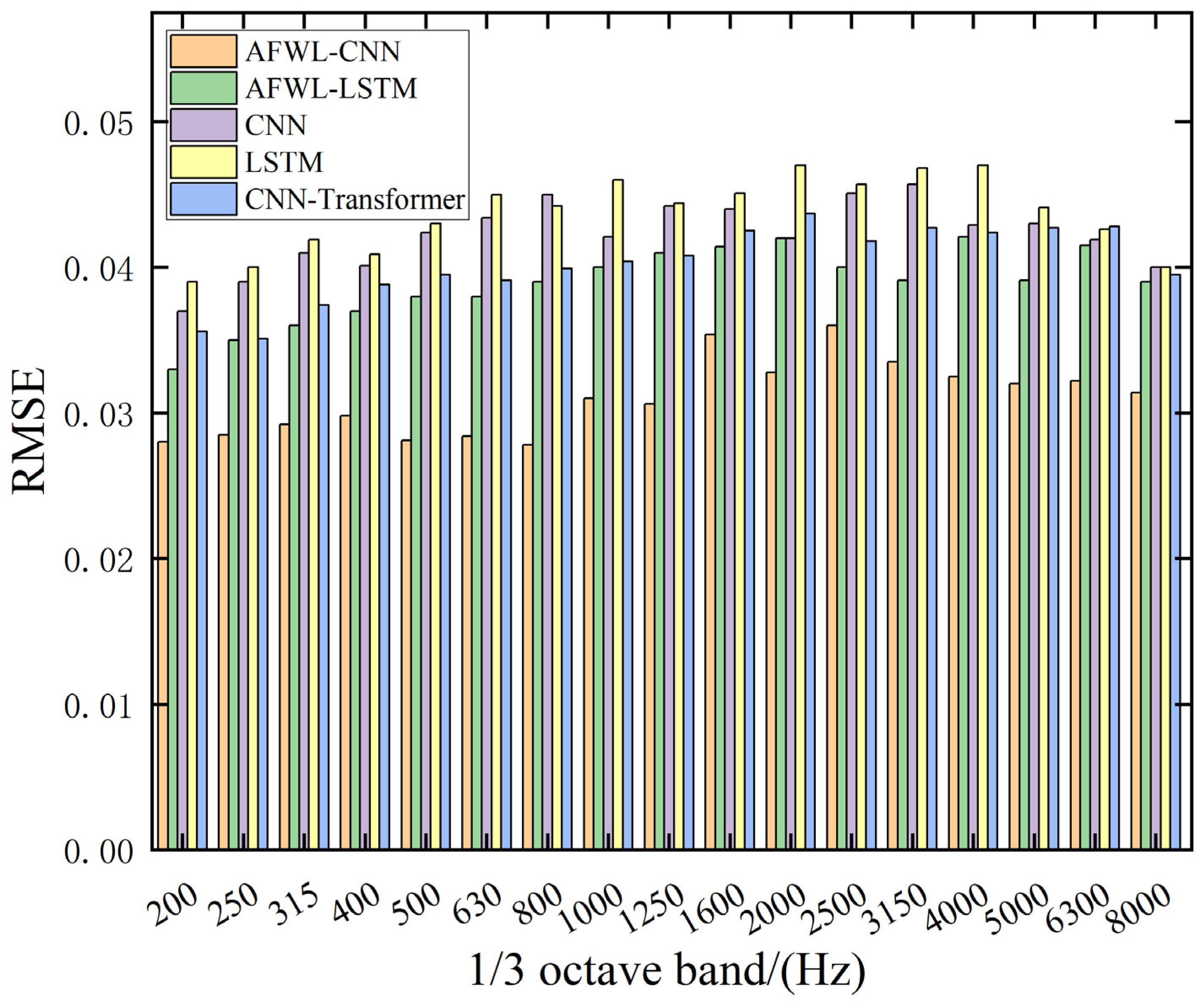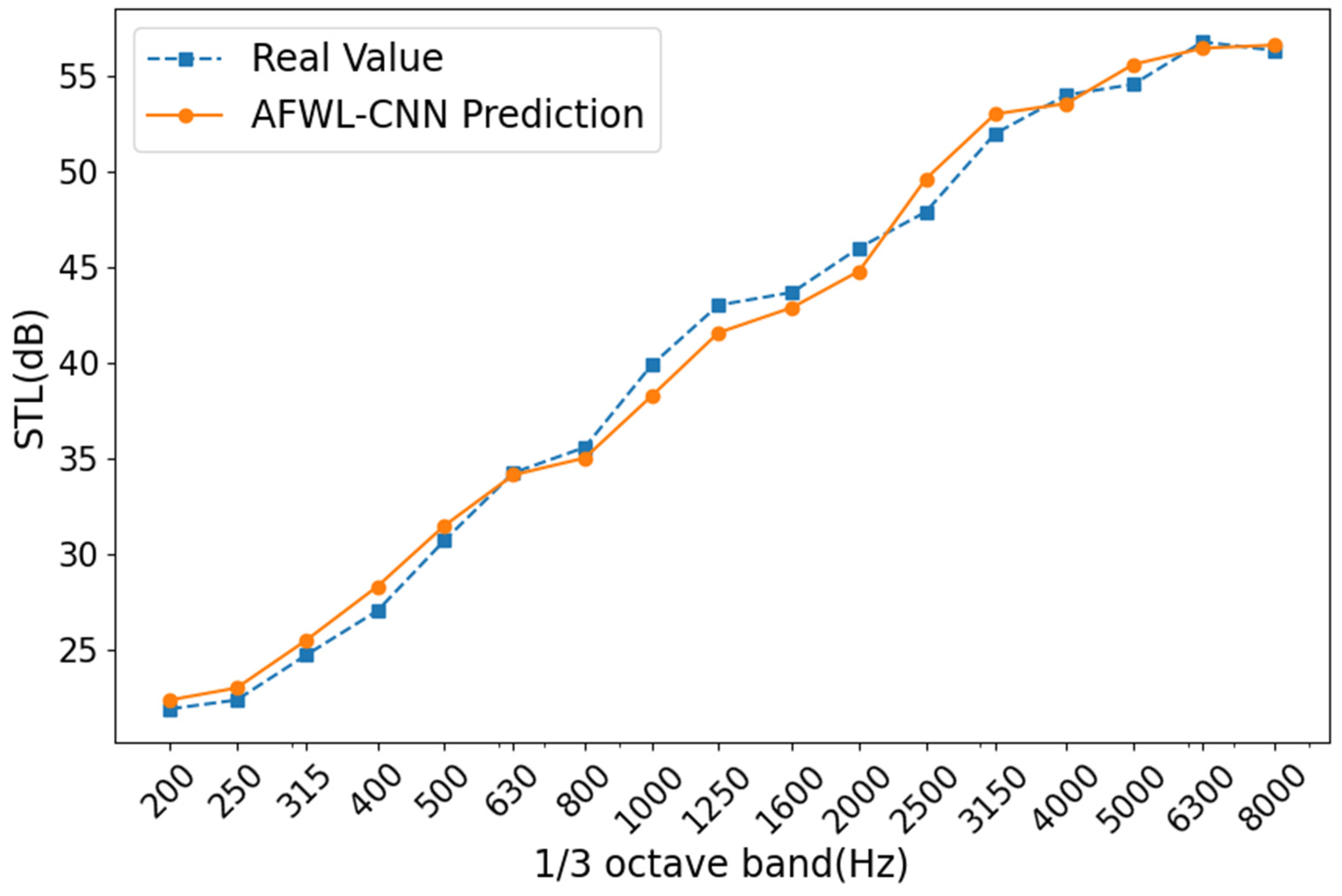1. Introduction
Noise, vibration, and harshness (NVH) performance is one of the key indicators for evaluating the comfort of a vehicle [
1,
2]. With improvements in living standards and the diversification of user demands, NVH performance has increasingly become a critical factor in reflecting the quality of a vehicle, with particular emphasis on the control of interior noise. As a structural system used to reduce interior sound pressure levels and improve airborne sound transmission characteristics, acoustic packages have a significant impact on the sound field characteristics of the entire vehicle [
3]. Among them, the front wall acoustic package is a key barrier that isolates powertrain noise from the passenger compartment and is the core component of an acoustic package system. Its sound absorption and insulation performance directly determine the NVH level of the entire vehicle [
4]. High-performance acoustic packaging not only helps reduce interior noise and improve ride comfort and quality perception but also plays a positive role in promoting vehicle weight reduction and cost control. Therefore, in-depth research and an accurate prediction of the sound insulation performance of the front wall system have important engineering application value and practical significance.
Currently, research on the sound insulation performance of front panels primarily relies on experimental testing and computer-aided engineering (CAE) methods [
5]. As a core means of high-frequency noise control, the design of acoustic packages is highly dependent on numerical simulation tools. In the CAE technology system, the statistical energy analysis (SEA) method has become a key tool for solving complex noise control scenarios in acoustic package design due to its specialized ability to handle vibration–acoustic coupling problems in the high-frequency range. With the engineering development of the SEA method, related research has made continuous progress. Chen et al. [
6] established a SEA model for domestic vehicle models, analyzed the causes of in-vehicle noise under idle conditions, and verified the simulation accuracy through experiments. Musser [
7] integrated SEA with material cost and quality constraints to achieve the synergistic optimization of acoustic performance and resource efficiency. Lee et al. [
8] studied the sound transmission loss of the acoustic system in pure electric vehicles (PEVs) based on SEA and used orthogonal testing to optimize sound absorption and insulation performance. Manning [
9] introduced a variance prediction model to extend the applicability of SEA in the mid-frequency range. Mistry et al. [
10] improved the accuracy of SEA modeling through sensitivity analysis. Tang et al. [
11] combined testing and simulation to construct a commercial vehicle NVH performance prediction model, controlling the maximum error within 2 dB(A). Avenati et al. [
12] proposed a new acoustic package design and experimentally validated its effectiveness in improving speech intelligibility and sound insulation performance in the mid-frequency range. Noguchi et al. [
13] utilized multi-layer structure estimation technology to balance lightweight and high sound insulation performance in the high-frequency range. Dong et al. [
14] achieved a reduction of approximately 3 dB(A) in interior noise by adjusting the ratio of rigid and flexible layers in firewall materials.
Although simulation methods such as SEA have achieved good results in front-end sound insulation research, their numerical results still need to be calibrated and verified using experimental data. In recent years, researchers have increasingly focused on establishing standardized, repeatable testing systems to enhance the accuracy and applicability of models. Ameduri Salvatore et al. [
15] validated the sound insulation model of door seals under cruising conditions by comparing prototype vehicle data with laboratory data. Zhang et al. [
16] studied the effect of floor and ceiling structures on impact sound insulation performance and pointed out that floating structures can effectively improve impact sound insulation. Chen [
17] combined gray correlation analysis and experimental optimization to achieve a multi-objective trade-off design of acoustic packages under high-speed conditions. Kronowetter [
18] developed a new type of wheel arch liner material that significantly improved the noise performance of the interior. Oettle and Sims [
19] proposed a variety of wind noise control strategies that effectively address the complexity of its propagation paths. Doutres and Atalla [
20], based on impedance tube experiments, proposed three acoustic measurement methods for evaluating the sound insulation performance of double-wall structure sound-absorbing blankets. Amadasi et al. [
21] proposed a method for measuring the sound transmission loss of 2D and 3D automotive body components using acoustic energy ratio and reverberation field control, solving the problem of standardization in sound insulation testing of small components. Accuracy was ensured through steel plate calibration and theoretical model verification, providing a practical tool for acoustic design in the industrial field.
Traditional methods are relatively mature in acoustic package design and optimization and have good engineering applicability, but there are still some limitations in practical applications. On the one hand, simulation-based methods rely on a large number of accurate parameters, and the modeling process is complex, requiring model verification and other difficult tasks. On the other hand, although experimental methods have high fidelity, they have long testing cycles and high costs, and they are easily affected by environmental factors, increasing the uncertainty of results. Compared with traditional methods, data-driven methods do not require the precise physical parameters needed for CAE. Instead, they directly utilize data-driven feature extraction, bypassing the high-fidelity physical modeling process, and are more adaptable to nonlinear or boundary condition-complex acoustic phenomena. Furthermore, they significantly improve efficiency compared with experimental, reduce testing costs and uncertainty, and are easier to integrate into end-to-end optimization processes to shorten optimization cycles, gradually demonstrating broad prospects in automotive acoustic design [
4]. These methods leverage large amounts of historical data and computational intelligence algorithms to automatically learn the mapping relationships between variables, and they have been widely applied in engineering modeling.
Existing research indicates that data-driven methods have significant advantages in automotive NVH optimization, mainly in the following aspects: First, they have the ability to extract potential patterns from high-dimensional multi-source data, which can effectively reduce dependence on physical modeling. Second, the modeling process is flexible and suitable for nonlinear systems and high-dimensional parameter scenarios. Third, automatic modeling and optimization functions significantly improve modeling efficiency and economy [
22]. Relevant studies have verified its effectiveness in acoustic package prediction and optimization. For example, Schaefer et al. [
23] constructed a mapping model of acoustic package material types and cost and weight based on neural networks, combined with a particle swarm optimization scheme, achieving a 15.21% and 9.7% reduction in weight and cost, respectively. Song et al. [
24] developed an NVH performance prediction process based on machine learning, shortening the development cycle while improving prediction accuracy. Huang et al. [
25] proposed an acoustic quality prediction model combining speed-tracking psychoacoustic indicators with adaptive learning rate convolutional neural networks (ALRT-CNNs), effectively reflecting the subjective characteristics of non-stationary noise inside PEVs. Wang et al. [
26] constructed a multi-objective mapping model to predict multiple sound quality metrics and achieve optimized control. Guo et al. [
27] designed a variable step size minimum mean square error algorithm to effectively suppress in-vehicle impact noise. Shang et al. [
28] utilized a genetic algorithm-reverse propagation neural network to study the influence of structural paths on sound quality. Luo et al. [
29] combined a microphone array with graph neural networks to identify noise sources in railway bogies, validating its advantages in array flexibility and cost control. Huang et al. [
30] further proposed a regularized deep convolutional neural network (CNN) model combined with neuron visualization technology to perform a quantitative assessment of sound quality.
Based on the above research, it can be seen that the sound insulation performance of front wall systems has highly nonlinear characteristics. Traditional finite element analysis or statistical energy analysis has limited accuracy when dealing with such problems, making it difficult to achieve high-precision predictions of actual performance. At the same time, although experimental testing can provide relatively accurate reference data, factors such as high cost and long cycles limit its application in rapid design iteration processes [
31]. Data-driven methods provide new ideas for solving the above problems. The data-driven front wall system sound insulation performance prediction method uses actual measurement data as input. It not only has the characteristics of easy parameter acquisition and high modeling efficiency but also can continuously improve the model performance through a continuous learning mechanism, thereby significantly improving the simulation accuracy while reducing the dependence on traditional experiments. However, existing data-driven methods still face challenges such as limited sample size and insufficient feature extraction in the modeling process, which in turn affect the generalization ability of the model [
32].
To further improve the accuracy and robustness of the front wall system sound insulation performance prediction, this paper proposes an adaptive feature weight learning convolutional neural network (AFWL-CNN) method based on adaptive weighted feature learning. This method enhances the ability to extract key acoustic features by introducing an adaptive weighting mechanism and combines the advantages of CNN in handling nonlinear mapping problems to significantly improve prediction accuracy and stability. This study aims to construct an efficient and scalable front surround sound insulation prediction model to provide theoretical support and technical paths for the rapid iterative design of automotive acoustic packages and promote the engineering application of data-driven methods in the field of automotive NVH optimization.
The structure of this paper is as follows:
Section 2 introduces CNN-related theories and proposes the AFWL-CNN method.
Section 3 introduces the front wall system sound insulation performance test plan based on the reverberation chamber–semi-anechoic chamber method and presents the original parameter table of the front wall system, as well as 60 sets of sample data based on the experimental design. In
Section 4, the AFWL-CNN prediction model is established, the prediction results are presented, and error analysis is performed.
Section 5 compares and analyzes the AFWL-CNN model with the CNN, Long Short-Term Memory (LSTM), AFWL-LSTM, and CNN–Transformer models; verifies the effectiveness of the proposed method through comparison of the results; and uses the model to predict a new set of front wall system parameters for comparison and verification with the measured values.
Section 6 summarizes the content of the entire study and explains the core contributions of this paper.
Section 7 discusses the limitations of this study and proposes directions for future research.
3. Experiments Using Front Wall STL
In acoustic package systems, sound insulation performance is usually evaluated based on the sound insulation index as a key performance indicator. The sound insulation index is used to measure the degree of attenuation of sound energy before and after passing through a material. It is defined as the ratio of incident sound energy to transmitted sound energy multiplied by 10, usually expressed as
(dB). The mathematical formula is shown in Equation (7):
In this formula, is the total sound energy incident on the material, is the sound energy transmitted through the material, and is the transmission coefficient.
Sound insulation is also commonly referred to as sound transmission loss (STL) [
45]. STL is defined as the logarithmic value of the ratio of the incident sound energy on one side of the structure to the transmitted sound energy on the other side, multiplied by 10, with units in decibels (dB). The higher the STL value is, the smaller the transmitted sound energy, indicating better sound insulation performance of the material. The expression for
STL is shown in Equation (8):
In the above equation,
is the incident sound energy, and
is the transmitted sound energy. These values can be calculated using the measurement results, and the expression is shown in Equation (9):
In the above equation, is the average sound pressure level in the reverberation chamber, in Pa; is the area of the measured object, in m2; is the air density, taken as 1.29 kg/m3; and is the speed of sound in air, taken as 340 m/s.
Given the acoustic characteristics of a reverberation chamber, such as low sound absorption, long reverberation time, and uniform distribution of sound energy, the sound pressure level at various spatial locations within the chamber remains essentially constant. The average sound pressure level within the chamber can be calculated by measuring the sound pressure levels at three locations using three sound sensors [
46].
In this equation, is the average sound intensity on the surface of the measured object, with units of W/m3. The average sound intensity of the measured object is obtained by measuring at multiple locations on the measured object using a sound intensity probe. is the area of the measured object.
Combining the above equations, we obtain the expression for calculating
STL:
In this study, we used the reverberation chamber–semi-anechoic chamber method to test the sound insulation performance of the front wall system, with STL as the evaluation index. The test process strictly followed the SAE J1400-2700 standard established by the Society of Automotive Engineers (SAE) [
47]. In the reverberation chamber–semi-anechoic chamber structure, the reverberation chamber served as the sound source chamber for arranging white noise excitation sources, while the semi-anechoic chamber served as the receiving chamber for obtaining the sound energy data of the test samples. The front wall system samples were installed at the test window between the two chambers. During testing, the excitation source generated a white noise signal with a total sound pressure level of 120 dB. Four sound pressure sensors were installed in the reverberation chamber to measure the sound pressure level under the reverberation field, while two sound intensity probes were used in the semi-anechoic chamber to measure the sound intensity values on the surface of the tested sample. Based on Equation (11), the STL values for each tested sample were further calculated. The experimental setup is shown in
Figure 3 and
Figure 4.
Based on the above test methods, a total of 60 sets of sample data on the sound insulation performance of pure electric vehicle front wall systems were obtained. The 60 sets of data were collected from five different models of pure electric vehicles. Among them, the STL test results of a set of front wall system samples under 17, 1/3 octave bands are shown in
Figure 5. The STL values in the low-frequency band (200–500 Hz) were low, indicating that the front wall system had limited ability to block low-frequency noise and a weak sound insulation effect. As the frequency increased, the STL value of the front wall system gradually increased, and the sound insulation performance gradually improved. In the high-frequency range (2000–8000 Hz), the sound insulation performance of the front wall system was excellent, and the sound insulation effect was significant.
The original structural parameters of a typical front wall system component of a pure electric vehicle used in the experiment are shown in
Table 1, which includes the total area of the three components of the front wall system and the sound insulation material coverage index. The thickness of the inner and outer front wall sound insulation pads is shown in
Table 2. The equivalent thicknesses of the inner and outer front wall sound insulation pads were calculated based on the thickness and area ratio of each acoustic package. The thickness parameters of the front wall sheet metal are listed in
Table 3. The equivalent thickness of the front wall sheet metal was calculated based on the thickness and area ratio of each sheet metal.
6. Conclusions
This paper proposes an adaptive weighted feature learning-based convolutional neural network (AFWL-CNN) method for predicting the sound insulation performance of the front wall system of pure electric vehicles. The prediction effect of this method was evaluated by comparing it with the AFWL-LSTM, CNN, LSTM, and CNN–Transformer models. Specifically, the sound insulation test of the front wall system was conducted based on the reverberation chamber–semi-anechoic chamber method, and 60 sets of sample data were collected, including 17, 1/3 octave STL values and their corresponding front wall sheet metal, inner front wall sound insulation pad, and outer front wall sound insulation pad areas and average thicknesses. The sound insulation performance of the front wall system was predicted using the AFWL-CNN model. The results showed that the root mean square error (RMSE) of the model was 0.031, the maximum absolute error (MAE) was 2.84 dB, the maximum relative error was 4.36%, and the inference time was 17.16 s, demonstrating the effectiveness of AFWL-CNN in predicting sound insulation performance. Furthermore, the AFWL-CNN model was compared with the AFWL-LSTM, CNN, LSTM, and CNN–Transformer models. The results showed that the CNN model was superior to the LSTM model in terms of prediction accuracy. Although the AFWL-CNN model increased the inference time compared to the CNN and CNN–Transformer models, it achieved a significantly improved prediction accuracy, and its RMSE value was lower than the other four models, demonstrating a reasonable trade-off between efficiency and accuracy and proving the effectiveness of the adaptive feature weight layer. Subsequently, the AFWL-CNN model was verified using a new front wall system sample data, and the prediction results were highly consistent with the actual data, further proving the accuracy and robustness of the model. Based on the comprehensive analysis results, the core contributions of this paper are as follows: (1) We innovatively introduced an adaptive feature weighting layer (AFWL), which can dynamically learn and emphasize the importance differences of input features (such as the area, thickness, and STL values at different frequency bands of sheet metal and sound insulation pads), effectively addressing the challenges of traditional mechanism-based modeling being complex and inefficient. (2) The proposed AFWL-CNN model outperformed AFWL-LSTM, CNN, LSTM, and CNN–Transformer models in terms of prediction accuracy, and its excellent accuracy and robustness were verified by new samples. (3) It provides a powerful new tool for data-driven performance prediction and optimization design of complex automotive acoustic packages.
